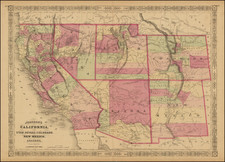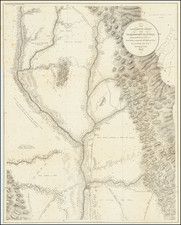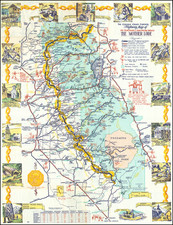Detailed map showing the resubdivision of Alamitos Beach, which would later be absorbed by Long Beach.
The map shows early streets, lots and the coastline, with lots noted as not yet abandoned.
Alamitos Beach was a part of Rancho Los Alamitos, one of five ranchos that resulted from the partition of the original Rancho Los Nietos grant given to Manuel Nieto in 1784. Nieto's grant was not only one of the first three awarded by the Spanish in Alta California, it was also the largest. After Nieto died, his children requested his original grant be partitioned. In 1834, Mexican governor José Figueroa officially declared Rancho Los Alamitos as one of the five partitions.
In 1844 the rancho was purchased by Abel Stearns, During the California Gold Rush, the rancho supplied much of the beef that would be herded north to feed the growing number of Immigrants who were flocking to the gold fields of Northern California from 1848 on.
After a disastrous drought in the 1860s, Stearns lost control of the ranch which was then sub-let to a number of farmers until the early 1880s when John Bixby, a cousin of Jotham Bixby and Llewellyn Bixby who controlled the adjacent Rancho Los Cerritos, bought the rancho along with a group which included his cousins and Isaias Hellman, the founder of the Farmers and Merchants Bank of Los Angeles.
Bixby developed the townsite of Alamitos Beach, which would eventually be assumed by Long Beach. Before Bixby, could do much more, he died suddenly in 1888, apparently an appendicitis attack, and Rancho Los Alamitos was separated between the three major parties-The developed Alamitos Beach properties were shared equally, while of the rest of the rancho, John Bixby's heirs kept the central section, the Bixby cousins from Rancho Los Cerritos assumed control of the northern portion of the rancho, and Hellman took control of the southern lands around present day Seal Beach.
Regarded as one of the giants of early California Surveyors, Charles T. Healey was educated at Perkinsville Academy, and began his career as a surveyor at a very early age.
Healey spent time in New York before going to California in 1854, where he arrived first in San Jose. He was employed as city clerk in San Jose from 1856 to 1858 and city engineer from 1862 to1866, during which time he received the rank of Captain as part of his role in the home guard of San Jose. He also served as county surveyor of Santa Clara county from 1856 to 1858. Healey also was the mining engineer of two quicksilver mines, the New Almaden and the Guadalupe, near San Jose.
During Healey's years in the area, it was said that he surveyed every Spanish land grant south of San Jose, California.
Healey began doing survey work in Southern California by the 1870s, when he was was invited by Jotham Bixby to survey the Rancho Los Cerritos, which included laying out a townsite that would eventually become Long Beach. This work would lead to his becoming the the first resident and surveyor for Willmore City, which would shortly thereafter be renamed as Long Beach, California.
Healey was the first licensed surveyor in California, following the creation of the California licensing provisions by the California Business & Professions Code, holding license number 1 granted by the State on July 20, 1891.
He has been recognized as one of "the giants of the land surveying profession."









![Map Showing the Summer Resorts on the Pacific Coast, adjacent to the lines of the Central and Southern Railroads. [California Tourist. Yosemite, The Big-Tree Groves Geysers, Monterey and other Popular Summer Resorts of Californa]](https://storage.googleapis.com/raremaps/img/small/41461.jpg)
![[Central Riverside County] Riverside Quadrangle](https://storage.googleapis.com/raremaps/img/small/83568.jpg)



